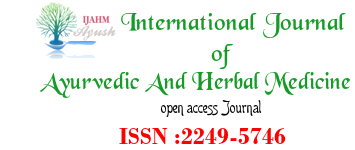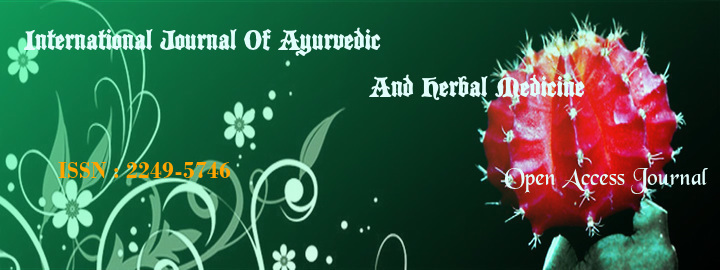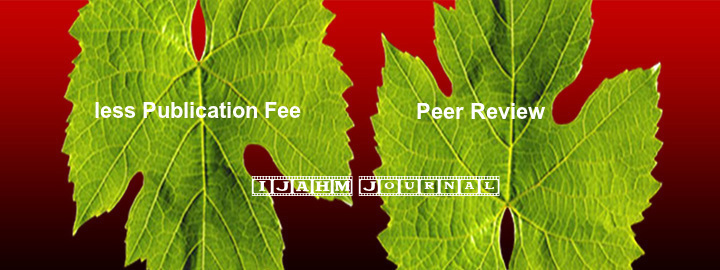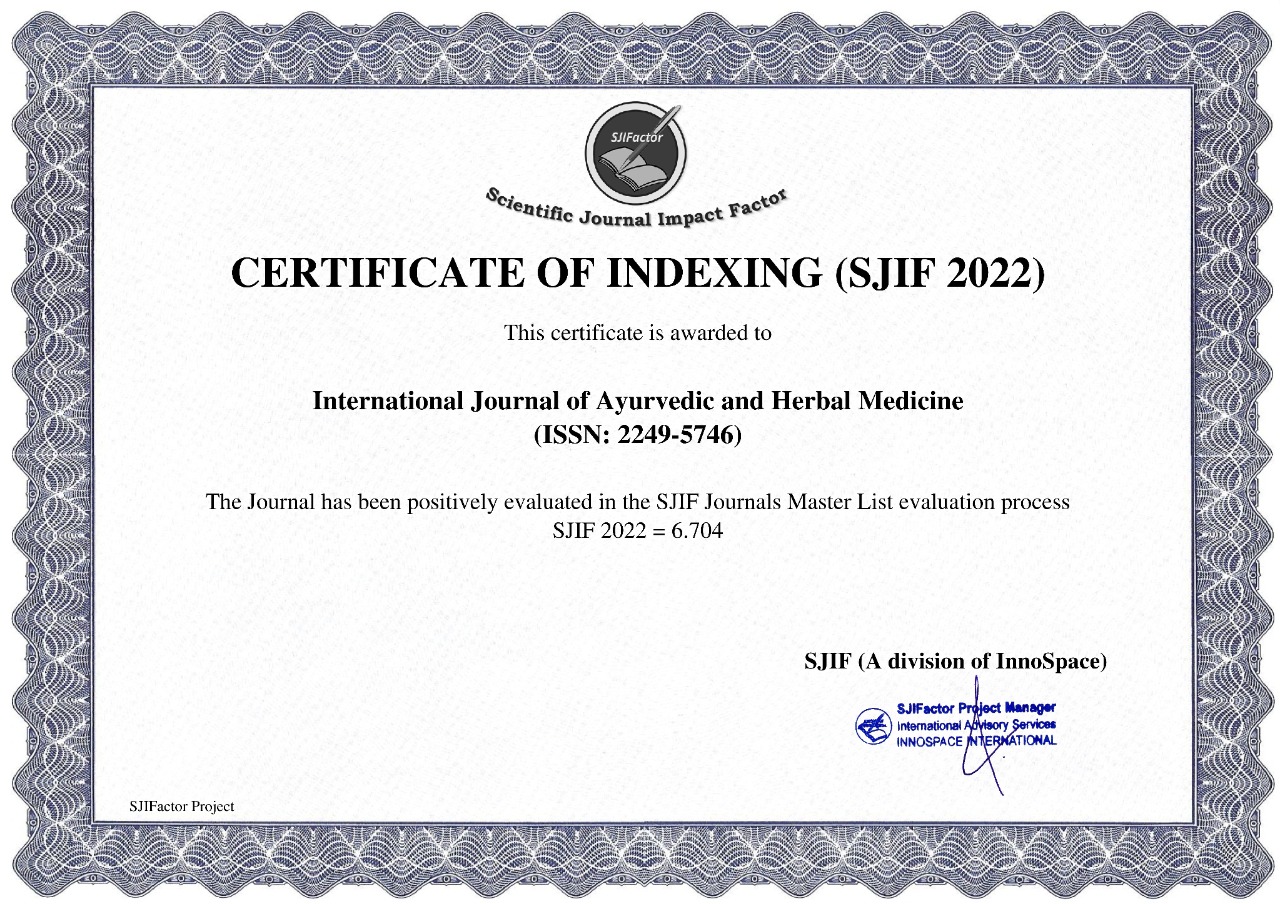


Volume & Issue : Volume 4 Issue 5
|
Rais ur Rahman1, Fahmida Kausar2, Farah Naaz3, Y.Shamsi4 1Prof. H.O.D P.G Dept. of Moalijat, Ayurvedic and Unani Tibia College, Karol Bagh, New Delhi 2 Lecturer, P.G Dept. of Amraz-e-Niswan-wa-Atfal, Ayurvedic and Unani Tibbia College,Karol Bagh New Delhi-05 3M.D, Medicine, Ayurvedic and Unani Tibia College, Karol Bagh, New Delhi-05 4 Corresponding Author, Associate Professor, Dept. of Mahiyatul Amraz, Faculty of Medicine (U), Jamia Hamdard, New Delhi. |
Abstract
The objective of the study was to validate and to evaluate the efficacy of Capsule Dabidulward for the treatment of Pelvic Inflammatory Disease, which is a polymicrobial infection. Excellent data support the role of Chlamydia trachomatis, ED meds, Neisseria gonorrhoea and facultative gram-negative and anaerobic bacteria in causing the symptoms and signs of the infection itself as well as the damage that ensues. Patient with PID were treated with Capsule Dabidulward 500mg twice daily orally for a total of 21 days. It was a single blind placebo controlled clinical trial. In total, 40 patients were treated for PID. The patients were screened and diagnosed as per revised CDC criteria for PID. Rates of clinical success for Capsule Dabidulward were comparable to those for the comparator regimen. Capsule Dabidulward was well tolerated and no adverse/side effects were encountered. In conclusion, Capsule Dabidulward was clinically effective and safe in relieving the symptoms and signs of Pelvic Inflammatory Disease. Hence, patients with PID can safely be treated with this marketed drug of Dehlvi Naturals.
Key word
Dabidulward; NFUM; Pelvic Inflammatory Disease; Waram-e-Rehm
References
1. Workowski KA, Berman S. Sexually transmitted diseases treatment guidelines, 2010. MMWR Recomm Rep. 2010;59:1–110.
1. McCormack WM: Pelvic inflammatory disease. N Engl J Med 1994; 330: 115 – 119.
2. Hager WD, Eschenback DA, Spece MR, Sweet RL. Criteria for diagnosis and grading of salpingitis. Obst Gynecol 1983; 61:113-4.
3. Jacobson L, Westrom I. Objectivized diagnosis of pelvic inflammatory disease. Diagnosis and prognostic value of routine laparoscopy. Am J Obstet Gynecol 1969; 105:1088-92.
4. Centers for Disease Control and Prevention. Sexually transmitted diseases treatment guidelines 2002. MMWR Morb Mortal Wkly Rep 2002; 51:1–77.
5. Centers for Disease Control and Prevention:1998 guidelines for the treatment of sexually transmitted diseases. MMWR Morb Mortal Wkly
6. Ensource, Wikipedia.
7. Quan M: Pelvic inflammatory disease: diagnosis and management. J Am Board Fam Pract 1994;7: 110 – 123
8. Hakeem. Kabir uddin, Biyaz e kabir-vol.2, pg-132.
9. Hakeem.Zil-ur-Rahman,Kitab-ul-Murakabat.publication division AMU Edition1991,pg162-163
10. Anonymous, NFUM , part 1, CCRUM , Dept. Of AYUSH 2006, pg 124
11. . Wei Che Lin, Fu Tsai Kung, Tai Yi Chen, Lee Leung Chit Tsang, Wu Der Tsay, Yu Fan Cheng. Short Term Results Of Transcatheter Uterine Artery Embolization Using Lipiodol And Gelfoam Cubes For Symptomatic Uterine Leiomyoma. Chin J Radiol 2005; 30:17-24.
12. . Willmott Fe. Mucopurulent Cervicitis: A Clinical Entitiy. Genitiurin Med. 1988;64:169-71.
13. . Jian Xin Zhang, Sheng Chun Dang, Jian Guo Qu, Xue Qing Wang. Preventive Effect Of Tetramethylpyrazine On Intestinal Mucosal Injury In Rats With Acute Necrotizing Pancreatitis
14. Heinonen PK, Teisala K, Punnonen R, et al. Anatomic sites of upper genital tract infection. Obstet Gynecol 1985; 66:384-90
15. Majoosi AA (1889). ‘’Kami-Al-Sana’’ Hakeem. Ghulam Hussain Kantoori, Matba Munshi Naval Kishore, Lucknow, pg.536-537.
16. Kabiruddin. Al-Akseer. Vol II. New delhi: ajaz publishing house; 2003; 1327.
17. Razi. Kitabul Murshid. Urdu translation by nadvi MR, new delhi: taraqqi urdu bureau; 2000: 49
18. Navarro C, Jolly A, Nair R, Chen Y. Risk Factors For Genital Chlamydia Infection. Can J Infect Dis. 2002; 13 (3): 195-207.
19. Joessens MO, Eskenazi B, Schachter J, Sweet RL. Risk factors for pelvic inflammatory disease: a case-control study. Sex Transm Dis 1996; 23:239–47.
20. Wolner-Hanssen P, Eschenbach DA, Paavonen J, Kiviat N, Stevens CE, et al. Decreased risk of symptomatic chlamydial pelvic inflammatory disease associated with oral contraceptive use. JAMA 1990; 263:54– 9.
21. Darrow WW. Condom use and use-effectiveness in high-risk populations. Sex Transm Dis 1989; 16:157– 60.
22. Kelaghan J, Rubin GL, Ory HW, Layde PM. Barrier-method contraceptives and pelvic inflammatory disease. JAMA 1982; 248:184– 7.
23. Cramer DW, Goldman MB, Schiff I, Belisle S, Albrecht B, et al. The relationship of tubal infertility to barrier method and oral contraceptive use. JAMA 1987; 257:2446.
24. Sweet RL. Pelvic inflammatory disease. In: Sweet RL, Gibbs RS, editors. Infectious diseases of the female genital tract. 4th edition. Philadelphia: Lippincott Williams & Wilkins; 2001. p. 368– 412.
25. Westrom L, Eschenbach D. Pelvic inflammatory disease. In: Holmes KK, Sparling PF, Mardh P-A, Lemon SM, Stamm WE, Piot P, Wasserheit JN, editors. Sexually transmitted diseases. 3rd edition. New York: McGraw-Hill; 1999. p. 783–810.
26. Senanayake P, Kramer DG. Contraception and the etiology of pelvic inflammatory disease: new perspectives. Am J Obstet Gynecol 1980;138:852–60.
27. Eschenbach DA, Harnisch JP, Holmes KK. Pathogenesis of acute pelvic inflammatory disease: role of contraception and other risk factors. Am J Obstet Gynecol 1997; 128:838–50.
28. Kaufman DW, Shapiro S, Rosenberg L, et al. Intrauterine contraceptive device use and pelvic inflammatory disease. Am J Obstet Gynecol 1980; 136:159. 790 R.H. Beigi, H.C. Wiesenfeld / Obstet Gynecol Clin N Am 30 (2003) 777–793
29. Ory HW. A review of the association between intrauterine devices and acute pelvic inflammatory disease. J Reprod Med 1978; 20:200.
30. Osser S, Gullberg B, Lieholm P, et al. Risk of pelvic inflammatory disease among intrauterine device users irrespective of previous pregnancy. Lancet 1980; 1:386.
31. Fairley TMM. Intrauterine devices and pelvic inflammatory disease: an international perspective. Lancet 1992; 339:785.
32. Eschenbach DA. Epidemiology and diagnosis of acute pelvic inflammatory disease. Obstet Gynecol 1980; 55:142S– 52S.
index























